Updated March 2023
Judicial Council reports include demographics of applicants for appointment
Each year, the Judicial Council of British Columbia reports to the province’s Attorney General and the public on its activities. Its latest report, published this summer, includes information about the Council’s membership and activities in 2018, as well as interesting data about applicants for appointment to the Provincial Court.
This eNews shares some of the Report’s highlights.
The main functions assigned to BC’s Judicial Council by the Provincial Court Act are to recommend and advise the Lieutenant Governor in Council (the provincial cabinet) on the appointment of Provincial Court judges, judicial justices, and justices of the peace; to oversee the delivery of education for judicial officers; and when necessary, to undertake inquiries into the conduct of judicial officers.
Who is on the Judicial Council?
The Judicial Council is composed of judges, lawyers, and lay persons, representing perspectives from both within and outside the judiciary.
Four of its nine members are appointed by the Lieutenant Governor in Council – currently these are lay members (meaning neither judges nor lawyers) who contribute varied backgrounds and valuable expertise to the Council’s work. They are: a member of the Leq:amel First Nation with wide-ranging business, government and volunteer experience; a retired police officer who has served on the Immigration and Refugee Board; a retired judicial justice who has volunteered with child and youth organizations; and a retired director of human resources with extensive HR experience and service on the BC Labour Relations Board.
The five other members are specified by the Provincial Court Act and are the Chief Judge and an Associate Chief Judge of the Court, the president of the Provincial Court Judges’ Association of BC, and the presidents (or their nominees) of the Law Society of BC and the Canadian Bar Association BC Branch.
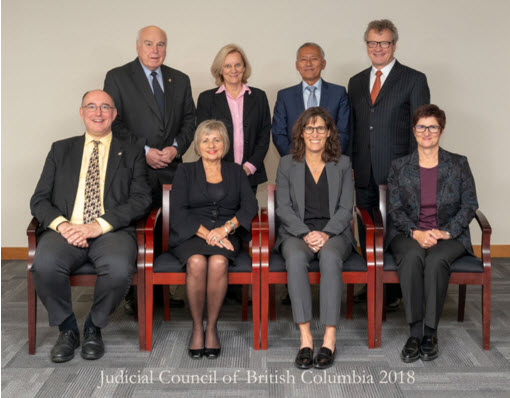
Left to right, back row: Gordon McRae, Patricia Schwartz, Alan Kazuta, Judge Mayland McKimm; front row: William Veenstra, QC, Miriam Kresivo, QC, Chief Judge Melissa Gillespie, Associate Chief Judge Susan Wishart; not pictured: Patrick Kelly (also Karin Kirkpatrick and Chief Judge Thomas Crabtree who served for part of 2018)
Judicial Council’s role in the appointment of Provincial Court judges
In Canada, judges are appointed to provincial courts by the provinces’ Lieutenant Governors in Council (the Lieutenant Governor acting on the advice of the provincial cabinet). In British Columbia the Judicial Council has screened and recommended candidates for appointment to the judiciary since the 1970s. The BC Attorney General selects from the candidates approved by the Judicial Council and makes recommendations to cabinet for appointments.
The Judicial Council has established criteria for judicial appointments that include a wide range of specific competencies. Applicants submit a detailed application and a peer review is conducted by a special committee of the BC Branch of the Canadian Bar Association. The Law Society of BC also provides a report to the Council for each applicant.. The Council reviews applications, conducts interviews, and recommends the most capable candidates to the Attorney General.
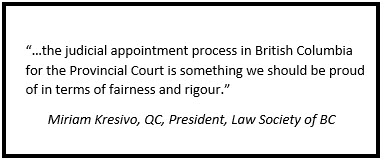
Numbers of applicants and appointments
A large influx of paper applications was received in August 2017, before the BC Judicial Council launched Canada’s first online application system for judicial appointment that September. In 2018, there were only 27 applications (significantly lower than the ten year average), but the Council continued to process 2017 applications along with the new ones, and recommended nine men and nine women from around BC for full-time appointment.
The Council also recommended four applicants for appointment as judicial justices, and 33 applicants for appointment as Court Services Branch justices of the peace.
Fifteen applicants were appointed as judges - the highest number in the last ten years (due in part to the addition of four judges to the Fraser region along with new courtrooms at the Surrey courthouse, BC’s busiest).
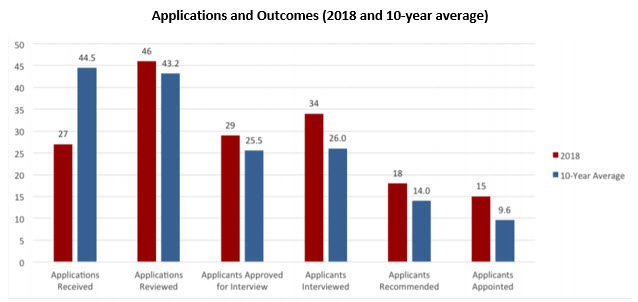
Applicants’ demographics and diversity
The Judicial Council attempts to ensure that the Provincial Court’s judicial officers reflect the diversity of BC’s population. It considers factors such as the applicants’ gender, age, ethnicity, residential region, and type of practice in its overall assessment, although it does not assign specific weights to them.
In 2013, the Council revised the judicial application forms to include information relating to the applicants’ ethnic or cultural background on a voluntary basis. The Canadian Bar Association Judicial Advisory Committee has recognized the BC Judicial Council’s yearly publication of application statistics as a “model of transparency”.
In 2018, 13 of the 27 applications included ethnic and cultural information. Three applicants indicated they were members of an Aboriginal group, 11 applicants indicated they were members of an ethnic or minority group, and eight indicated they were members of a diverse group.
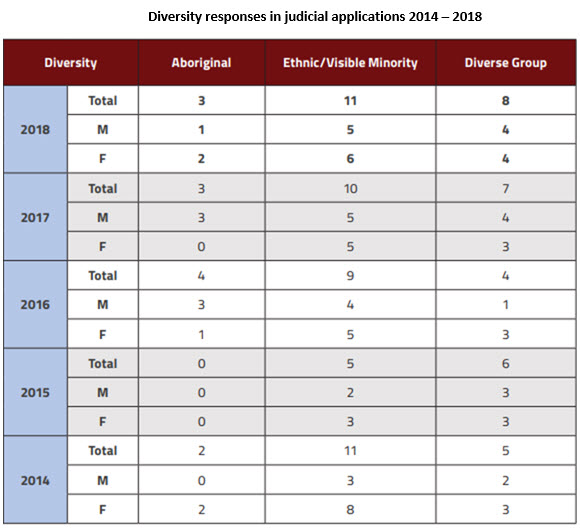
Gender
In 2017, four men and ten women were appointed to the bench. In 2018, eight women and seven men were appointed. The graph below shows applicants and outcomes by gender. Note that applications processed in 2018 may have been submitted in the preceding year.
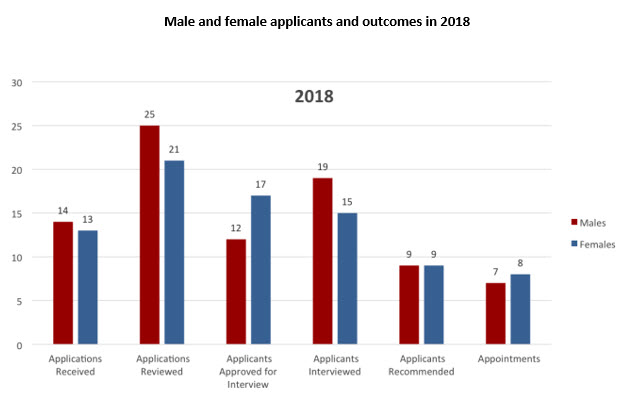
The graph below shows ten-year averages for applicants and outcomes by gender. Over the past five years, 32 women and 25 men have been appointed to the Provincial Court bench.
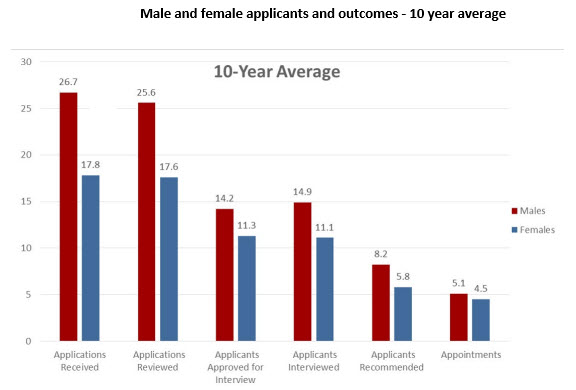
Age, years and area of practice
Applicants in 2018 had an average of 22 years in the practice of law: 21 years for males (below the ten year average) and 23 years for females (above the ten year average).
The average age of applicants to the Court in 2018 was 53 years for males (slightly below the ten year average) and 51 years for females (slightly above the ten year average).
While applicants from private practice have often tended to form about two-thirds of the total number, in 2018 they formed only 52%, while applications from Crown counsel formed 37% and those from other areas formed 11%.
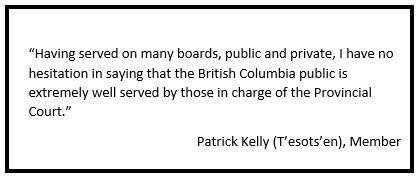
Judicial Education
The Judicial Council supports the Court’s judicial officers in ongoing judicial education. Judicial education is currently organized on behalf of the Judicial Council by the education committees of the Provincial Court Judges’ Association and the Judicial Justices’ Association, with support from the Office of the Chief Judge.
Other Matters
The Judicial Council’s responsibilities include improving judicial service, investigating complaints when necessary, and preparing a judicial code of ethics. In December 2014, the Judicial Council adopted the Ethical Principles for Judges published by the Canadian Judicial Council to guide the Court’s judicial officers in their conduct. No formal inquiries into a judicial officer’s fitness for office were held in 2018.
Find out more
The BC Judicial Council’s 2018 Annual Report provides more details about all these topics.
To assist judges and judicial justices with difficult ethical and professional issues and to assist members of the public to better understand the judicial role, the BC Judicial Council has adopted the Ethical Principles for Judges published by the Canadian Judicial Council in 2021, except for its commentary on “Post-Judicial Careers” in s. 5.E.2 restricting the types of activities a judge can engage in upon leaving the judicial office and returning to the legal profession.

